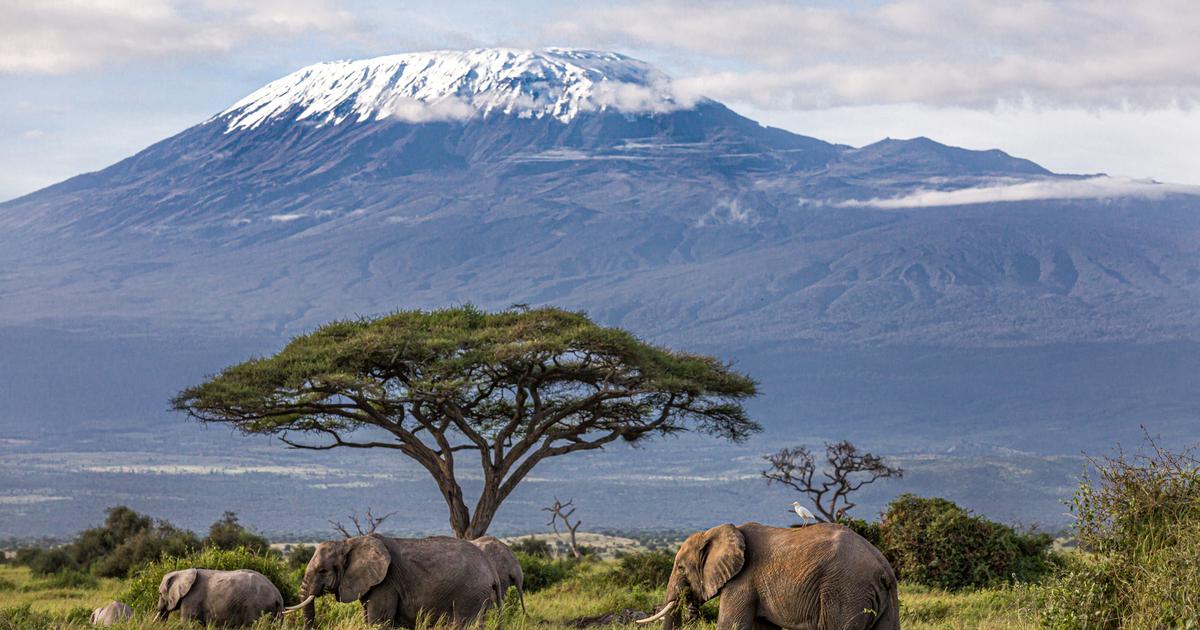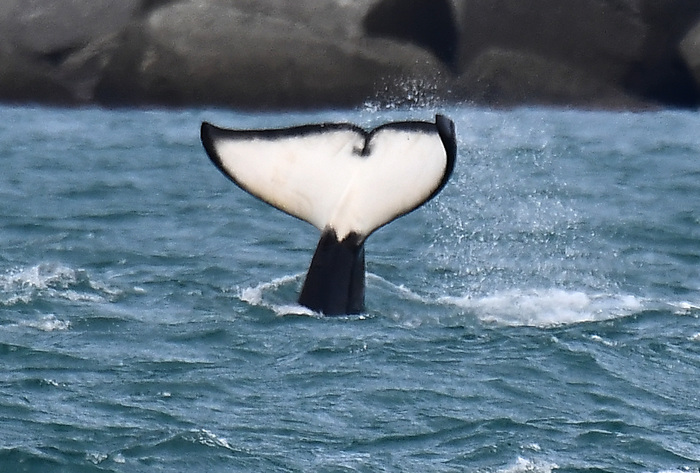Who looks like this, is a pop star: snow-white fur, pale yellow mane and gray eyes. "Elegant and beautiful," says Jason Turner. As his Land Cruiser approaches, Matsieng and Zukhara look up briefly. Their heads lift for a moment, then their eyes close again, their heads sink back into the grass. You know Turner and his vehicle.
It's a late afternoon in July, and the two white lions lazily creep in the savanna grass. Now and then they turn around and lift their round bellies in the air. "This was probably just eaten here," says Turner.
photo gallery
10 pictures
Lions in South Africa: white as snowJason Turner fights for the survival of one of the rarest wild cats on earth, less often than the legendary snow leopard of the Himalayas. In 2018 exactly 24 white lions lived in the wild - all in South Africa. Together with his wife, animal rights activist Linda Tucker, Turner founded the Global White Lion Protection Trust (GWLPT) in 2002. The non-profit organization has set itself the task of saving the animals from extinction.
In 2004, the first white lions were released to their private Tsau nature reserve near Hoedspruit on the edge of the Kruger National Park. Today there live eleven, almost half of the free-living population. On a lonely piece of savanna, barely 20 square kilometers in size. There are also two white lions in the nearby Timbavati Game Reserve and one in the Kruger National Park. The remainder live outside their original habitat in two private game reserves near Cape Town.
Black noses, white fur
The coat of Turner's lions is almost as white as snow. But only almost, because they are not albinos. "This mood of nature is inherited by a recessive gene that only occurs in northeastern South Africa," says Turner. "Albino lions have a reddish tint on the nose, lips, and eyelids, and these animals have black noses, blue-shimmering pupils, and black lines around their eyes."
The color white is not exactly an evolutionary recipe for success. In the competition of the species it has brought more disadvantages than advantages, especially if you are a hunter and does not want to be seen. At least scientists thought that for a long time. But in a seven-year study, Turner, who graduated with a master's degree in wildlife management from the University of Pretoria, found that there is no significant difference in hunting success between brown and white lions.
Records from locals indicate that white lions have been living in the Kruger National Park and the Timbavati region for a very long time. They were first sighted by Europeans in 1938. Since the 1970s, animals have been hunted for their fur and bones, bred as hunting trophies and exhibited in zoos. Between 1993 and 2006, not a single white lion lived in the region. Today there are just 14 free-living animals, where the gene is visually evident.
120,000 euros for a white lion
Only lions that are white or carry the gene for the color mutation can also bear white offspring. According to the Mendel principle, the probability of fathering white juveniles is 25 percent for two brown lions carrying the white gene. If one parent is white, the other is brown, it is 50 percent. If both parent animals are white, the offspring will know with a probability of 100 percent.
But why are the animals even white? "We know that color customization is one of evolution's oldest propositions, and perhaps the animals are still white since the last ice age," says the scientist. Turner found the genetic marker in collaboration with an international research team in 2013.
His hope then: The white lion in northeastern South Africa could finally be classified as an endangered subpopulation, because on the Red List of Endangered Species of the World Conservation Organization (IUCN) white lions are not managed separately to this day, but together with their brown conspecifics.
But Turner has a problem: In the rest of Africa, the IUCN has classified lions as "endangered". In South Africa, by contrast, the protection status of the big cats has just been downgraded to "not endangered". "A disaster that puts the lions of South Africa under even greater pressure," says Turner. In addition, some farmers breed lions such as chickens.
In South Africa, about a thousand lions are shot each year in "canned hunting" in specially set up breeding stations. The trophy price for a normal lion is between 4500 and 25,000 euros, for a male white lion at more than 120,000 euros.
Four babies from Gaia
South Africa's rarest predator has become a symbol of people's greed, of the failure of species conservation and, above all, of the ignorance of politics. For this reason, Turner and his wife have repeatedly called on the South African government to increase the protective measures for the endangered subpopulation.
Together, both wrote petitions to animal rights activists, politicians and even to current South African President Cyril Ramaphosa. It was not until February 2019 that they presented a petition to Parliament opposing the ruthless slaughter of prey cats in breeding stations and trophy hunting in the wild. With success: Now Parliament is again addressing the issue.
getting there
South African Airways (www.flysaa.com) flies from Frankfurt and Munich via Johannesburg to Phalaborwa on the edge of the Kruger National Park. Return flights cost from 900 euros. Several other airlines fly to Johannesburg from German airports. From Phalaborwa it takes half an hour by rental car to the Kruger National Park, and in less than an hour to the private Timbavati Reserve and Turners Tsau Conservancy.
entry
Germans do not need a visa for South Africa. In order to receive the maximum of three months valid "Visitor's permit" upon entry, a machine-readable passport is required, which is still valid at least 30 days beyond the date of departure.
Best travel time
April to October. In the South African summer between November and March, it can be very hot and humid in northeastern South Africa.
accommodation
For example, in one of the state lodges in the Kruger National Park (Tel. 0027/12/4289111, www.sanparks.org) or in the Motswari Game Lodge in the private Timbavati Game Reserve. It has 15 luxurious bungalows with bathrooms. The night costs from 300 Euro per night and person in a double room for two nights minimum stay (Tel. 0027/21/4275900, www.newmarkhotels.com).
Global White Lion Protection Trust
Since this is a scientific project, the private Tsau Conservancy is not officially open to visitors. However, it is possible to join a group of visitors or to participate in five- and eleven-day volunteer programs. Dates, Prices and Booking: Tsau Conservancy, Guernsey Road 81 KU, Portion 21, Greater Timbavati, South Africa, Tel 0027/15/7930657, www.whitelions.org.
health
Especially in the rainy months between November and March you should protect yourself against malaria. In addition, it is advisable to refresh the protection against hepatitis A and B as well as the quadruple vaccination against polio, diphtheria, tetanus and whooping cough. Pay attention to drinking water hygiene!
Further information
South African Tourism Board,
Peace Road 6-10,
60311 Frankfurt,
Tel. 0800/1189118 (free),
www.dein-suedafrika.de
It is evening. Turner is back at the wheel of his SUV. When the sun goes down, the crickets sound like circular saws, the savanna shines yellow, the scientist stops again. This time he is holding two female animals: Nebu and Zihra from the Shidolo pack. As Turner turns off the engine, the two press their heads against each other, entwine themselves with their powerful cocks and lick their faces.
Nebu and Zihra are also radiant white. And they look strong. Good thing, because in the long run Tucker and he want to buy another 3500 hectares of land and tear down the fences to the surrounding reserves. "Our goal is to give the animals even more space and expand their gene pool," says the scientist.
And Turner is confident: In December 2018, the white lioness Gaia gave birth to four healthy white chicks from his Shidolo pack. Of course, the rare cat is not over the mountain. But Turner is certain: the animals may have a chance if the human does not continue to add to them. "Because the white gene," said the scientist, "the white gene is in them."












